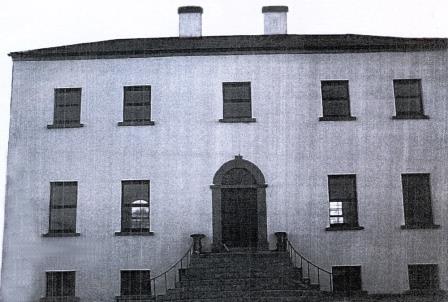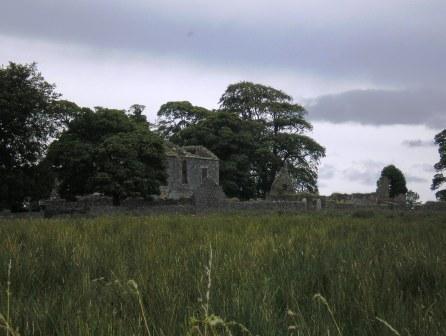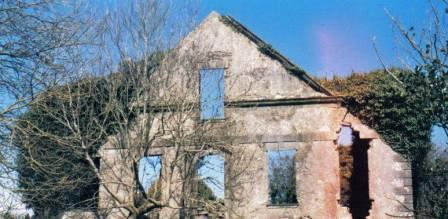Bella
Houses within 10km of this house
Displaying 38 houses.
Houses within 10km of Bella
Displaying 38 houses.
| House name | Description | |
|---|---|---|
| Lisserlough | Lisserlough was part of the King (Viscount Lorton) estate but was let on long leases to a number of different families, notably Powell, Baker and Laurence. McTernan notes that the present house was built by Viscount Lorton in the 1850s. It is still extant and has been restored while the adjacent out-offices have been converted into apartments. | |
| Rathtermon | Taylor and Skinner indicate Rathtermon as a seat of the Fleming family in 1783. In 1837 Lewis records Rathtermon as the seat of J. Flanagan. At the time of Griffith's Valuation, Rev. John Flanagan was leasing a property valued at £10 together with over 200 acres at Rathtermon, barony of Coolavin, to Phillip McDermott. Rathtermon is still the focus of a large farming enterprise. |

|
| Estersnow Glebe | At the time of Griffith's Valuation the Ecclesiastical Commissioners were leasing a house at Cavetown valued at £10 to Rev. Frederick Hamilton. It is described as "a good glebe house, the residence of the incumbrant of Estersnow" at the time of the 1st Ordnance Survey. It is still extant and occupied. | |
| French Park | At the time of Griffith's Valuation Frenchpark was owned by Rev. John Ffrench, Lord de Freyne and was valued at £60. In the 1749 Census of Elphin it was the residence of Arthur and Lady French. In 1786 Wilson described it as "a most beautiful seat with extensive and noble demesnes". It was demolished in the twentieth century. Members of the French family were buried in the graveyard surrounding the ruins of Frenchpark Priory. |

|
| Ballymore | Alex Popham was leasing a house valued at £17 to Andrew Irwin at the time of Griffith's Valuation. Writing in 1786 Wilson refers to Ballymore as the seat of Pooley Shuldham, who may have been connected with the Longford family of that name. In 1814 Ballymore was the seat of Edward Elwood. In 1837 Lewis recorded it as the seat of Rev. J. Elwood. It is described as " a mansion in the possession of the late Rev. Elwood's family" at the time of the first Ordnance Survey. A house is still extant at Ballymore. |

|
| Knockadoo | Knockadoo was the home of the Knott family in the mid 18th century. Robert Knott was resident there in 1749. Robert Elwood was leasing a house at Knockadoo from Viscount Lorton at the time of Griffith's Valuation. it was valued at £24. In the 1870s it is recorded as the address of Joseph Bennett Little. Earlier, at the time of the first Ordnance Survey it is described as "a fine mansion resided in by Owen Lloyd". A farm is still extant at the site. | |
| Camlin | The representatives of John Irwin, a minor, were leasing a house at Camlin, valued at £14, to James Badger, at the time of Griffith's Valuation. In 1837 Lewis also recorded Camlin as the seat of the Irwin family. At the time of the 1st Ordnance Survey, Camlin was being leased by John Irwin from the estate of Guy Lloyd and was described as "a good house of three stories". In 1814 it was the seat of John Irwin. At the time of the 1749 Census of Elphin a John Irwin lived at Camlin. |

|
| Moylurg House | In 1837 Lewis records Moylurg house as the seat of the Dick family. Rev. William Robertson was leasing a property valued at £25 to John Johnston, at Clogher, parish of Eastersnow, at the time of Griffith's Valuation. This appears to be Moylurg House which is still extant. Moylurg was the home of Major Henry Taaffe Ferrall in the 1870s. |

|
| Cavelawn | Guy Lloyd was leasing a house at Faus valued at £10 to James Acheson at the time of Griffith's Valuation. The house at this site is labelled Cavelawn on the 25-inch Ordnance Survey map of the 1890s. A house is still extant at the site. | |
| Havarine Cottage | Anna Maria Fry was leasing a house valued at £11 from Lord Lorton's estate at Tullyvohaun, barony of Boyle, at the time of Griffith's Valuation. At the time of the first Ordnance Survey Havarine Cottage, at Tullyvohaun, was described as a ''gentleman's seat', the residence of Mrs. Fry. | |
| Croghan | At the time of Griffith's Valuation, Guy Lloyd was the occupier of the house at Croghan, valued at £40. In 1749 the Census of Elphin shows that J. Lloyd, spinster, lived there. Wilson also notes it as a seat of the Lloyd family in 1786. Croghan House is no longer extant but an extensive range of outbuildings remains. |

|
| Cloverhill | At the time of Griffith's Valuation, Thomas Cox was leasing a house from the Lloyd estate at Bunreagh, barony of Boyle, valued at £10 . This property is labelled Cloverhill on the 25-inch map of the 1890s. A house and substantial farn are still extant at the site. | |
| Hermitage | Lewis records the Lloyd family occupying a second house called Hermitage also located in the townland of Croghan. Buildings still exist at the site. | |
| Dooneen | The representatives of Daniel Ferrall were leasing a property valued at £5 together with 200 acres to John Sharkey at the time of Griffith's Valuation. A farm is still extant at this location. | |
| Scor More | At the time of Griffith's Valuation, Scor More was leased to Patrick Beirne by the Lloyd estate and was valued at £3. 100 acres was also leased. This house is not shown on the 1st edition of the OS map. | |
| Kingsland | At the time of Griffith's Valuation John Conmee was leasing a property valued at £12 from Viscount Lorton's estate at Kingsland, barony of Frenchpark. He had been in possession of this property since at least 1814. Matthew Conmee also leased a property in the same townland, valued at £6 together with 190 acres, from Lord Lorton's estate. |

|
| Barnaboy | Francis O'Grady was leasing a property at Barnaboy, barony of Frenchpark, valued at £4 15s together with 179 acres of land from William Longfield's estate at the time of Griffith's Valuation. Farm buildings exist at the site now. | |
| Portobello | At the time of Griffith's Valuation, John Stafford was leasing a property at Portobello valued at £13 from Lord Lorton's estate. In 1814 it had been the residence of Thomas Stafford who Lewis also recorded as resident there in 1837. | |
| Ratra House & Stables | Lord de Freyne held a house valued at £4 10s at Ratra, barony of Frenchpark, at the time of Griffith's Valuation. In 1814 Ratra was the residence of Henry Irwin. A house, labelled Ratra, is shown on the 1st edition Ordnance Survey map. A larger building, on a different site, is labelled Ratra House on the later 25-inch edition [M684939]. Neither of these house are extant now. Offices, the property of Lord de Freyne's estate and valued at £7 10s, were located at Clashcarragh, barony of Frenchpark, at the time of Griffith's Valuation. |

|
| Sheepwalk | James McGann was leasing a property at Sheepwalk, barony of Frenchpark, valued at £10, from Lord de Freyne's estate at the time of Griffith's Valuation. The townland of Sheepwalk contains a fine collection of early to mid-twentieth century houses and associated farm buildings. One house, now derelict, appears to be earlier and has large associated outbuildings. |

|
| Cloonshanville | William Davis was the occupier of a property valued at £8, together with over 120 acres at Leggatinty, barony of Frenchpark, at the time of Griffith's Valuation. In the same townland he was leasing a property, including a corn mill, valued at £18, to James McCann. In 1814 Paul Davis was resident at Clonchanville, Frenchpark and Lewis records this as the seat of J. Davis, in 1837. The 1749 Census of Elphin records W. Davis resident at Clegarna in the parish of Tibohine. Only some foundation stones of Cloonshanville Mill remain. There is a house, probably not original, on the site of Cloonshanville House. |

|
| Ballyglass | Henry Sampey was leasing a property at Ballyglass, barony of Castlereagh, valued at £15, together with 260 acres from the Ferrall estate. In 1837 Lewis recorded Ballyglass as the seat of R. Kelly.It continued in the possession of the Kelly family who had worked for the Sampey estate. In 1894 recorded as the seat of A.W. Sampey. In 1749 the Census of Elphin recorded it as the residence of Terence McDermott. There is still a house on the site at Ballyglass though it may have been modernised, together with extensive yard and walled garden. |

|
| Hermitage | Built by Charles O'Conor (1710-1790) the antiquarian and head of the family circa 1760. His great great grandson Charles O'Conor was leasing the property at Ballaghcullia, valued at £10, to Honoria O'Conor at the time of Griffith's Valuation. In 1749 the Census of Elphin records Denis O'Conor as being of "Ballinagar". The house at Hermitage is still extant though not occupied and a modern bungalow has been constructed in front of it. |

|
| Kilcorkey | Denis O'Conor held a property including a mill, valued at £10, at Kilcorkey, barony of Castlereagh, at the time of Griffith's Valuation. In 1749 the Census of Elphin recorded Richard Rutledge, gentleman, as the holder of a property in Kilcorkey. A house and extensive outbuildings still exist at the site but both have been modernised. The outbuildings have been coverted to living accommodation. An impressive standing stone is visible in the field close to the rear of the house. |

|
| Mount Druid | Denis O'Conor's house at Mount Druid, barony of Castlereagh, was valued at £35 at the time of Griffith's Valuation. In 1814 and 1837 the house was the seat of Matthew O'Conor. Slater refers to it as the seat of Charles M. O'Conor in 1894. A modest house survives at the site of Mount Druid but the stable yard remains are more elaborate. Fine trees still exist in the former demesne land. |

|
| Killaster | Denis O'Conor was leasing a property valued at £4 together with 100 acres at Killaster, barony of Castlereagh, to Patrick Coyne at the time of Griffith's Valuation. The house is still extant and occupied. |

|
| Peak | Richard Irwin owned a herd's house and over 370 acres at Peak, barony of Castlereagh at the time of Griffith's Valuation. A modern house has been constructed at the site. | |
| Mullen | In 1837 Lewis records a house named Mullen as the seat of Lynch Plunkett. The 1749 Census of Elphin records Mullen or Mullin, in the parish of Tibohine, barony of Frenchpark, as the residence of J. Barlow. The house, labelled Mullen, is shown on the 1st edition Ordnance Survey map but does not appear on the later 25-inch edition of the 1890s. | |
| Rathkeery Glebe | Rev. William French was leasing a glebe house at Glebe East, barony of Frenchpark, from Lord de Freyne's estate at the time of Griffith's Valuation when it was valued at £7. The house no longer survives but an entrance gateway and trees indicate its whereabouts. |

|
| Cavetown | In 1786 Wilson notes Cavetown as the seat of the Rev. Dean Mahon and the Reverend Arthur Mahon resided there in 1814. At the time of the first Ordnance Survey a ''gentleman's seat of two stories'' is noted in Cavetown. Guy Lloyd is recorded as the proprietor. This may be the property, valued at £5, leased from the Lloyd estate by Geo. Laird at the time of Griffith's Valuation. There are buildings still extant at this site. |

|
| Granny | At the time of the first Ordnance Survey Granny was described as ''a good farmhouse, the residence of the proprietor'' who was Thomas Irwin. Both Leet and Lewis record the Irwin family having a seat at Granny, near Boyle, in 1814 and 1837 respectively. A modern building is extant at the site now. | |
| Rushfield | At the time of the first Ordnance Survey Mr. A. Irwin is noted as the occupier of one of two ''gentlemen's seats' at Tullyvohaun, barony of Boyle. In 1814 it was the residence of John Irwin. This property was valued at £8 and was occupied by William Phibbs at the time of Griffith's Valuation. A substantial farm still exists at the site. | |
| Mantua | Built in the mid 18th century and owned by the Grace family in the 18th and 19th centuries. Occupied by R. Underwood in 1778. In 1786 Wilson notes that it was the seat of the late Richard Underwood and of Captain Grace. The 1st edition Ordnance Survey map indicates that it had elaborate gardens with a fishpond and terrace. It was owned by Edward F. Bowen in 1906. Mantua is now a ruin. | |
| Clogher Beg | Mary Gormley writes that this house was built by the Knoxes who acquired some of the Plunkett of Castle Plunkett estate. Occupied by Thomas Stafford at the time of Griffith's Valuation, held from James Murphy. | |
| Raheen | Occupied by Major Fawcett in 1837 and by John Irwin in the mid 1850s who held the property from Francis Murphy. In 1840 John Irwin had married Margaret Harken of Raheen House, Elphin. |

|
| Bettyfield | Recorded as the seat of Sir John Conroy or O'Mulconry in the Ordnance Survey Field Name Books. Arthur O'Connor was the main tenant in the townland of Shankill at the time of Griffith's Valuation. | |
| Ardgallin | At the time of Griffith's Valuation Harloe Baker was leasing a house valued at £7, together with over 80 acres, at Ardgallin, barony of Coolavin, from Viscount Lorton's estate. Lewis also records Ardgallin as the seat of Harloe Baker in 1837. McTernan notes that the Baker family sold their interest to Thomas Bell, of Larkhill House, Quarryfield, in 1887. It came into the ownership of the Cornwall family in the 1920s who are still in possession. | |
| Bellanagare Castle | Bellanagare was the home of the O'Conor family including the well-known historian Charles O'Conor. It is noted by Wilson as his seat in 1786. He later built Hermitage House some distance away and Bellanagare Castle is now in ruins. |

|

